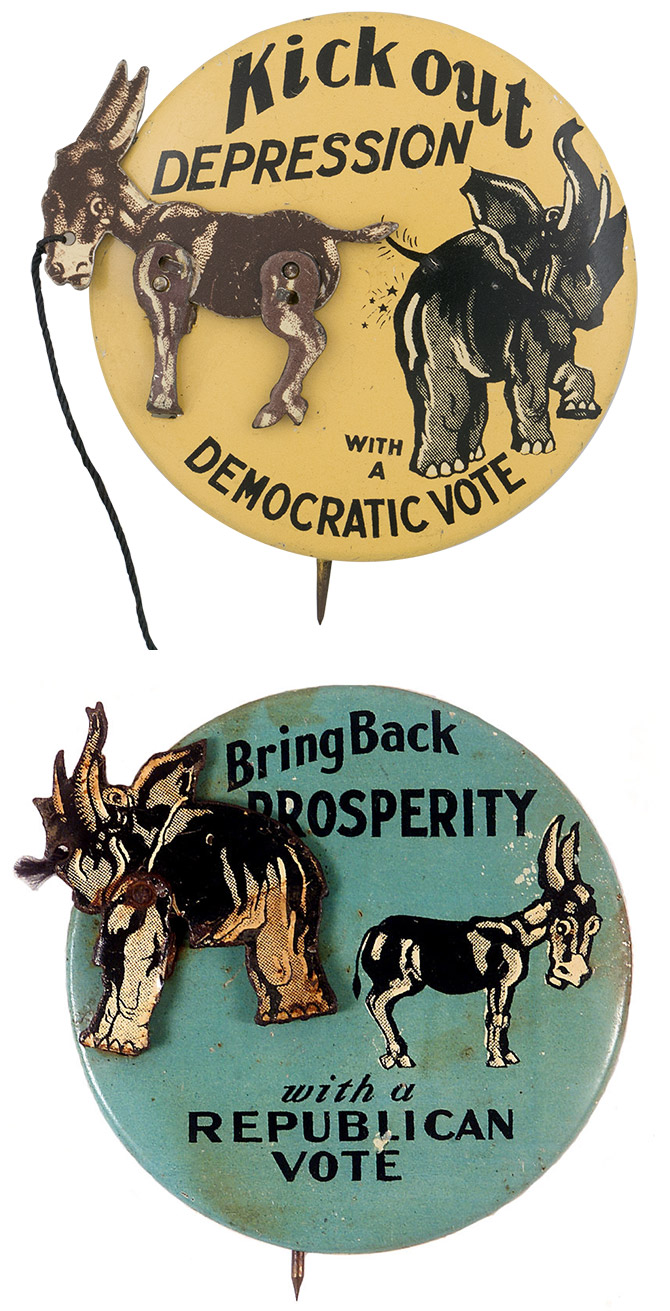A Look Back at Buttons
Since their inception, buttons have constantly been reworked, retooled, and repurposed in both their design and function. In the case of the United States, buttons used for political means were first observed all the way back in 1789, and were then sewn to the lapels on coats or worn as pendants that were tied to a string. It would not be until 1896 that pinback buttons, which rely on a pin, clutch, or other mechanism to temporarily fasten to a garment, would be patented. From there, contemporary buttons have utilized many of these same designs, but nevertheless, from time-to-time, there continues to be occasional modifications and improvements made by inventors. One example that illustrates this comes from George Haumann, whose mechanical buttons offered an innovative and unique function that hadn’t been previously seen in the buttons that came before.
The Story of George Haumann and the Character Display Co.
Owner of the Character Display Co. in Chicago, George Haumann was an inventor whose company primarily made mechanical and animated signages and figures, many of which decorated department store windows all throughout the city. Indeed, Haumann’s work was popular enough that the company even had an animated exhibit at the 1933 World’s Fair. The exhibit displayed a large mineral encyclopedia of Illinois, which to the amazement of onlookers turned its pages on its own. Fashioned in the actual shape of Illinois, the encyclopedia continually changed pages to reveal information on the various rock layers on which the state is built from, their geological ages, and depths. An impressive piece, Haumann continually utilized mechanical displays in a variety of his other works, which included books and figurines. Perhaps most impressive was when Haumann utilized the same methods from his other creations and applied it to a new territory: buttons.
The Birth of the Mechanical Button
 During the 1932 presidential campaign, Haumann adapted the methods he used in his other works and began applying them to buttons, specifically ones for the election. The election saw President Herbert Hoover face off against his democratic rival, Franklin Delano Roosevelt. The election came at a particularly polarizing time in the countries history given the ongoing economic depression taking place. Hoover’s inadequacies in maintaining the economy proved detrimental enough that Roosevelt won the election in a landslide, with 57% of the popular votes and forty-two of the forty-eight states being democratic overall.
During the 1932 presidential campaign, Haumann adapted the methods he used in his other works and began applying them to buttons, specifically ones for the election. The election saw President Herbert Hoover face off against his democratic rival, Franklin Delano Roosevelt. The election came at a particularly polarizing time in the countries history given the ongoing economic depression taking place. Hoover’s inadequacies in maintaining the economy proved detrimental enough that Roosevelt won the election in a landslide, with 57% of the popular votes and forty-two of the forty-eight states being democratic overall.
Capitalizing on the increasing popularity of political buttons, Haumann designed and personally hand assembled a series of buttons for the election while Green Duck was the manufacturer. The buttons came in two variations, with one showing a donkey, the symbolic mascot of the Democratic Party, striking an elephant, its Republican counterpart, and vice versa. Of note, the pro-democrat button carried the slogan “Kick out Depression with a Democratic Vote” while the pro-republican button said “Bring Back Prosperity with a Republican Vote.” What is especially unique about these buttons is that in each version, the wearer can pull on a string and depending on which variation of the button is being worn, the one mascot will actually kick its counterpart.
The Mechanical Innovation and the Future
Never before had a button been designed to incorporate actual moving parts into its design. In crafting the button, Haumann allowed for a more life-like and visually interesting button to inhabit the election season. Over time, other manufacturers came to produce mechanical buttons. One example comes from the Evans Novelty Company, who during the 1940s produced a series of mechanical buttons that showed Uncle Sam pulling on a string. Upon pulling the string, an image of Adolf Hitler pops up, showing the German leader being hung by a tree. Though mechanical buttons never came into the same level of popularity as the more standard pinback buttons, they continue to be interesting artifacts that paint a more visually unique portrait of the past.
Throughout their existence, buttons have, as mentioned, been revitalized numerous times. Though a seemingly simplistic little piece, buttons have to the surprise of many shown the ability to adapt and be reconfigured from time-to-time. There is no doubt that inventors, such as George Haumann, will continue to periodically present new designs and functions for pinback buttons. It remains to be seen what the full potential of these little fasteners will be.
See more of the Button Museum's mechanical buttons.











